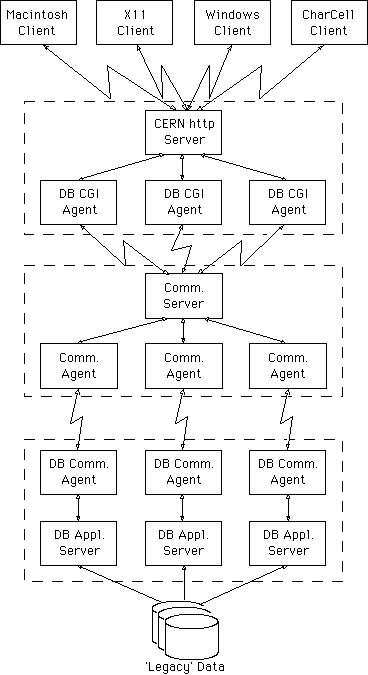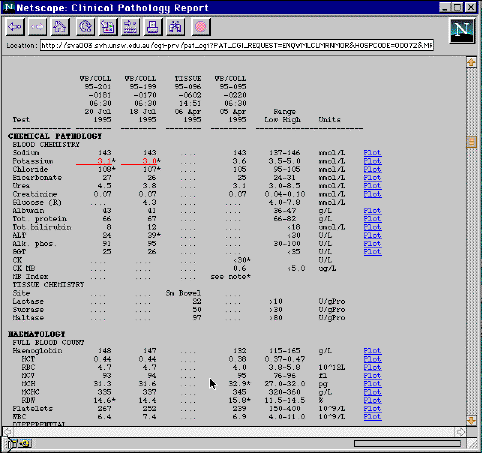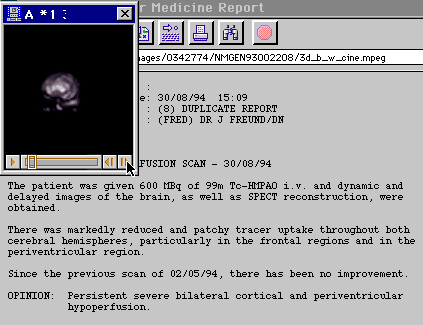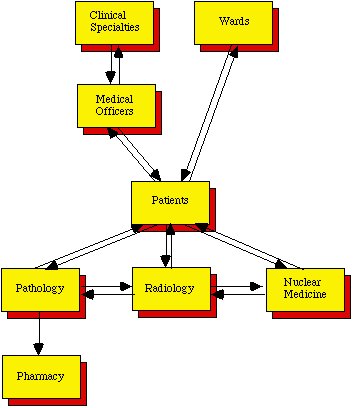Local time: Sunday, 20-May-2007 10:37:04 EST
Last update at /special/conference/apwww95,Friday, 21-May-2004 09:47:23 EST

St.Vincent's Hospital Sydney - WebResults Project
Michael Czapski,
Manager, Information Systems,
St.Vincent's Hospital Sydney,
Victoria Street,
DARLINGHURST, NSW, 2010,
Australia
M.Czapski@svh.unsw.edu.au
- Abstract
- Clinical practise in a modern acute care hospital relies heavily on access to, and interpretation of data provided by a wide variety of diagnostic services. The problem for clinicians is the ease of access to information relevant to specific patients for both diagnostic and management purposes. The solution, at St.Vincent's Hospital, is the WebResults; a WWW-based, integrated, platform independent interface to the multiple underlying patient and diagnostic results 'databases', medical images, graphs and clinical reference material.
- Keywords
- medicine, pathology, radiology, pharmacy, imaging, results reporting, clinical references, integration, legacy interfaces
Contents
- Introduction
- Objectives
- Solution
- Strengths
- Weaknesses
- Future plans
- Conclusions
- Acknowledgments
- References
Introduction
Clinical practise in a modern acute care hospital relies heavily on access to, and interpretation of data provided by a wide variety of diagnostic services. The data may be as diverse as medical imagery, image interpretation reports, textual and discrete test results and graphs from the different disciplines in pathology, radiology and nuclear medicine. In particular, automated pathology instruments generate massive amounts of data in a short time frame.
Usually a number of laboratories would exist as discrete organisational units, each dealing with specific aspects of diagnostic work. These would most likely be supported by a number of discrete computerised laboratory applications with their own data repositories, code sets and data storage structures.
Clinical decision making requires access to diagnostic information in its totality, unhindered by the organisational divisions or intricacies of computerised laboratory systems. In case of discrete results, variations of values over time, including variations across patients' episodes of care, are of critical importance. Ready access to the relevant reference material is also invaluable, particularly in diagnosis and treatment of rare or complex conditions.
This access has traditionally been in the form of paper reports. Whilst all information was eventually available, the frequency of 'report runs' was a compromise between efficiency and timeliness. To reduce the delay inherent in paper-based provision of results character-cell-terminal-based enquiry software for specific laboratory applications was introduced. There would likely exist a number of such enquiry applications depending on the number of discrete laboratory applications. The benefits of access to results on demand would sometimes be severely reduced by the time it typically took to navigate through the number of enquiry applications, frequently requiring separate authentication, and the differences in their user interface and reporting formats design.
To overcome some of these limitations, Information Systems Department of St.Vincent's Hospital developed/evolved a custom character-cell-terminal-based Results Reporting application. The application, Ward Enquiry Facility (WEF), provides integrated access to patient administration and all major computerised diagnostic databases in the Hospital. Since the application is character-cell-terminal-based, access is available to textual information only.
It was the advent of Word Wide Web technology, and the HyperText, together with the NCSA Mosaic WWW Browser, and its followers, that opened up new possibilities for development and implementation of distributed, extensible, platform independent, multi-media capable and user friendly information systems. Just the kind needed to deliver the Clinical Information system.
Between March and June, 1994, the St.Vincent's Campus-wide Web (SVCWW) was established. Between July and November, 1994, the WebResults system was developed as a pilot project, very much part-time and unofficially. It was inspired by the "Virtual Hospital" exhibit of the University of Iowa. It built on the St.Vincent's Campus-Wide Web implementation and the integration experience of the Ward Enquiry Facility. To the 'legacy' data integration it added platform-independent graphical user interface, close integration of patient information across laboratory systems and hooks to sample medical imagery. Between November, 1994, and May, 1995, new laboratory and Patient Administration systems, which were being implemented in the Hospital, were integrated. June 1995 saw the WebResults go live in St.Vincent's Private Hospital in Sydney as a results reporting system integrated with the DeLacy Patient Administration and Order Entry system in use there. Subsequently, a facility for plotting of discrete pathology results was added and hooks to St.Vincent's "Formulary and Guide to Prescribing" were provided.
This paper describes the objectives of the WebResults project, the solution developed at St.Vincent's Hospital and the future plans for the use of the WWW technology in support of patient care.
Objectives
One of the major objectives of the project was to provide tools to assist clinicians in access to data from a variety of patient administration, diagnostic services and medical imaging databases, and a selection of reference material both local and maintained elsewhere. Especially important was direct access to operational Radiology, Nuclear Medicine and Pathology information, both current and historical.
Further objective was to provide a common user interface for clinicians working at different locations on the St Vincent's campus (St.Vincent's Public Hospital, St.Vincent's Private Hospital, St.Vincent's Clinic) on a variety of hardware / operating system platforms.
Another objective was to provide interpretative information relevant to the data optionally accessible to the user. This was felt to be particularly important in a teaching hospital due to a significant population of less experienced young doctors, and a high proportion of complex medical problems requiring the ordering and interpretation of rare and unusual diagnostic tests.
It was necessary to achieve maximum integration of disparate, distributed patient information held in proprietary repositories. Ideally a clinician using the system would be unaware of the underlying source of information he/she was viewing. Or the fact that a single document might contain information collected from multiple discrete repositories as well as 'derived' information such as graphs.
Custom development work had to be reduced to development of proprietary repository interfaces. This too had to be minimised by utilising existing interfacing code resources and standard technologies for user interface and data communications.
Given the almost proverbial financial constraints of the public health system and the ever-growing cost of the public health provision it was necessary that the solution was not merely cost-effective but low cost, preferably 'free'. This was further necessitated by the initial unofficial nature of the project, hence the absence of any seed funding.
Solution
Architecture
The solution developed at St.Vincent's Hospital is based on standard WWW Browsers, CERN http Server, custom Communication Gateway and a custom Application Server. Whilst an independent effort, parts of it are similar in spirit to that described in [Wil94].

Implementation Details
Since standard WWW Browsers are the clients, any WWW Browser on any operating platform can be used. These in use at the site are predominantly NCSA Mosaic for X, DOS/Windows and Macintosh, although Netscape is gaining popularity on all these platforms.
Standard CERN httpd version 3.0 is used to serve the static documents and, through the CGI mechanisms, to interface to the Communication Server. The httpd is deployed on the Alpha/Digital Unix (OSF/1) platform.
The DB CGI Agent, invoked by the httpd, retrieves a number of CGI environment variables, packages these as a series of name/value pairs and, through the Unix domain socket IPC mechanism, passes them to the Communication Server. It then waits for the response document and, through the stdout, passes it to the http Server for delivery to the requesting WWW Client.
The Communication Server merely relays the requests and the responses between the DB CGI Agents and the Application Servers. In that it acts as a protocol conversion gateway. It is implemented as a Concurrent Server. Upon startup it creates a pre-defined number of children, Communication Agents, each of which causes one Application Server process to be started on the VAX side. Over the course of execution it hands down the requests to the appropriate free Communication Agent and proactively creates more children if the workload increases such that all children are busy. This proactive behaviour is necessitated by the relative 'costliness' of creating a process on the OpenVMS platform and the resulting performance penalty to the requestor. By creating a new process in anticipation of its use the penalty to the requestor is avoided.
The DB Communication Agents and Application Servers (bask-end) are two logically distinct parts of the same image operating within the context of a network process on the Digital VAX/OpenVMS platform. All of the 'legacy' data repositories, currently integrated into the WebResults, reside in the VAX/OpenVMS environment. The WEF interface code was also developed on the VAX/OpenVMS platform and could be readily utilised for WebResults. The Application Server uses a stateless, request-driven processing model. Each request is treated independently of any previous or subsequent request. All information necessary to process the request is provided with each request. Only common resources, such as repository connects, translation caches, and the like, are build/maintained across requests.
Protocols/Standards
Custom Stateless Application Protocol discipline is imposed to convey navigation requests between the user and the Application Server. Each protocol request message contains all information necessary for the back-end to satisfy the request. In response to a request the Application Server generates a HTML document which, in addition to the requested information, contains navigation links with further protocol request messages embedded. As en example, the application protocol request message
ENQWMLCLMRNEOM&HOSPCODE=someCode&MRN=someMRNis an enqiry message (ENQ) , for WEF discrete results legacy interface (WML) to Clinical Pathology's data repository (CL), using Medical Record Number (MRN), where the required Hospital Code and the Medical Record Number follow the End of Message Trailer (EOM) as name/value pairs. In response to that request the Application Server would produce a virtual document similar to the one below.

WWW Browsers and Servers communicate using HTTP. The virtual documents, generated by the Application Server, are HTML 2.0 documents, some with Table extensions.
The virtual graphs are GIF images. Sample medical images and animations are GIF, JPEG and MPEG. The fidelity of the image display and the degree of control the user has over the image depends on the quality of the desktop platform and the image viewer. An example of 'animation', displayed on a Macintosh platform using an external viewer, is given in the figure.

Proprietary graphic formats, such as these generated by imaging instrumentation, are under consideration. Their deployment is subject to availability of appropriate viewers and cost of implementing these across multiple client platforms.
Whilst communication between the WWW Browsers and the WWW Server takes place using TCP/IP protocol suite, the communication between the Communication Agents on the Alpha/Digital Unix and VAX/OpenVMS platform uses DECnet Task-to-Task facilities. The latter was necessitated by the absence of the TCP/IP support on the target VAX systems, and the cost of providing it, rather than any special design requirement. The acquisition and implementation of the TCP/IP support software on the VAX systems would simplify the communication solution and improve request processing efficiency.
Information Structure
Virtual Documents, presented to the user, imply certain structures consistent with the underlying hierarchy of information. The links embedded in the documents aid in the navigation of this hierarchy. A request for a list of patients with the name of Smith, for example, would result in a list of patients being returned. Selecting a specific patient from the list would bring brief patient demographic information and links to all available diagnostic laboratories. Selecting a laboratory would, in turn, produce diagnostic report or a list of diagnostic reports for the patient. Selecting another laboratory would produce diagnostic report for the same patient for the new laboratory, and so on.Part of the information hierarchy is depicted below.

Areas covered
Legacy Repository Interfaces
At present there are five distinct legacy repository types interfaced to the WebResults. These interfaces provide access to data residing in seven discrete legacy repositories. This is so that access to data from both the current and the recently superseded systems is available.The repositories cover the areas of Patient Administration, Pathology, Radiology and Nuclear Medicine.
Patient Administration
Interfaces to the current HBOC "Precision Alternative" and the
superseded
HOSPAS Patient Administration systems provide access to Patient
demographics by
Medical Record Number, Episode Number, History Number and Names,
as well as
lists of patients of an Admitting/Attending Medical Officer, within a
Clinical
Specialty/Clinical Unit or in a Ward. The patient demographics
document for a
patient contains links to the diagnostic reports and related
information.
Nuclear Medicine and Radiology
Interface to HOSREP provides access to lists of Patients by Names and Diagnostic Reports by Medical Record Number.Pathology
An indirect interface to the current Cerner PathNet and a direct interface to superseded HOSLAB and HOSREP allow access to lists of Patients by Names and Diagnostic Reports by Medical Record Number. The specific areas of Pathology are Anatomical Pathology, Chemical Pathology, Clinical Pharmacology, Haematology, Haemostasis, Microbiology/Virology, Serology and Transfusion Medicine.Pharmacy
St.Vincent's Formulary and Guide to Prescribing, 1995, recently published in a book form, is on-line in HTML format. The Microsoft Word source document has been converted using automated tools, with minimal hand markup. The document tree was subsequently indexed, giving it a searchable index supporting simple boolean queries. Links from the appropriate diagnostic reports to the appropriate sections of the Formulary are included in the system
Examples
For reasons of privacy and confidentiality there is no access to the WebResults from outside the Hospital. The dynamic nature of the information and the number of legacy repositories involved make it impractical to provide a demonstration version which contains dummy data. The links below are a small but reasonably representative selection of the virtual documents, graphs and images available through WebResults.
- St.Vincent's Home Page
- with the link to the WebResults
system.
WebResults 'Main Menu'.
- Patient Administration
- 'Main Menu', Find Patient by MRN form,
brief patient demographics and
admission history.
- Nuclear Medicine
- A list of requests and
a patient report with links to supporting
imagery
and a screen-shot of a frame of an
animation sequence.
- Radiology
- A patient report with a thumbnail-
sized image link to a
large size X-ray image. The image is a
sample only. It is not related to the report.
- Microbiology
- A list of requests and
two screens of a
patient report.
- Clinical Pathology
- A patient report,
sample clinical reference text
displayed when the 'low potassium' link is activated,
and the relevant section of
St.Vincent's Formulary and Guide to
Prescribing, dealing with
Potassium. Also, Chloride results graphed
and
tabulated. Another
pathology report
, using Mosaic for X, showing 'strip menu' of laboratories,
a 'cumulative' Chemical Pathology report,
and
a Haemoglobin graph.
- Pharmacy
- The 'title' page of the St.Vincent's
Formulary and Guide to Prescribing
showing index facility.
Strengths
The single greatest strength of the solution is the platform independence of the client. WebResults is accessible from any platform supporting a standard WWW Browser.
The second greatest strength of the solution is its low cost. No new hardware infrastructure was required to implement the WebResults. Both the client platforms, the VAX/OpenVMS and the Alpha/Digital Unix platforms were in existence for other reasons/applications. Large amount of existing 'legacy' interface code was used in development of the back-end Application Server. Only the Communication Server/Communication Agent software was developed from scratch. The total cost of the system, consisting solely of staff salaries, is of the order of A$22,000. That compares very favourably with A$250,000+ costs of third-party GUI-based results reporting solutions.
The client architecture permits delivery of image, animation, sound and other media types to the desktop 'out of the box'. This holds a great promise for the provision of access to medical imaging using low-cost desktop devices; a capability formerly available only through expensive, specialised imaging solutions.
As new systems became implemented, or new information sources become available further functionality can be added to the solution in a transparent manner. The inherent initial complexity of the solution is reduced to the complexity of adding new interfaces to the existing back-end Application Server. Furthermore, it is not even necessary to provide new information through the existing Application Server. New information can come from a totally different system and still integrate transparently into the WebResults.
These benefits accrue principally from the imaginative use of the World Wide Web technology.
Weaknesses
HTML 2.0 lacks immediate form field validation capabilities [Ber95]. Proposed HTML 3.0 appears to provide SCRIPT form attribute, however the scripting support itself is not a part of the proposed standard [Rag95]. It is uncertain whether and how field validation will be provided in the future. This makes it impractical at this time to implement more complex forms such as might be required for data acquisition.
The solution involves a number of distinct pieces of software, co-operating across three or more different platforms. Initial development and implementation requires a non-trivial amount of knowledge on part of the developer(s) /implementor(s) in the areas of networking, both TCP/IP and DECnet, Unix System Administration, OpenVMS System Management, http server configuration and management, HyperText Markup Language, software development on both platforms using a variety of programming languages, and internals and data structures of a number of proprietary 'legacy' data repositories. This, in turn, increases the complexity of on-going support and troubleshooting.
World Wide Web technology, as used in WebResults, departs so far from the traditional notion of a computerised application system that it may be difficult to train some of the less gifted users. The information presented is a part of a greater store of information available to peruse. Having navigated outside the WebResults hierarchy, some users may become 'lost' and unable to return to the relevant pages.
Future plans
The potential, inherent in the WWW technology, is far from fully explored by the WebResults.
Some of the short term plans relate to addition of further information sources such as clinical reference materials with searchable indices, e.g. Drug Bulletins, Clinical Protocols and Emergency Handbook. These require merely that the material be available in electronic form.
At present the imagery is provided as samples only. Work is in progress on transparently linking Nuclear Medicine Imagery from the image server to the relevant diagnostic reports at the discretion of the Nuclear Medicine Department.
One of the side-effects of providing access to diagnostic information though the patient-related information is that as more information from various areas becomes available an electronic medical record will be constructed over time. To that end it is intended to provide links to Nursing Dependency and DRG-related information in the first instance and to other areas later. It is intended to provide transparent links to Pharmacy information; medication dispensed and drug interactions.
There is a potential to integrate the expert system technology, in use at St.Vincent's, such that an expert comment can be provided to a clinician on demand, merely by activating a link from the chemical pathology test result.
In the longer term it is intended to explore the potential of the technology for data acquisition. The first couple of areas of interest being on-line Discharge Summaries, Order Entry for Ancillary Services and Order Entry for Diagnostic Services. The first and the last of these hold a particular promise in conjunction with diagnostic reports already available. It is conceivable that a clinician, perusing a pathology report for a patient, will merely point at a test already performed or a set of related test he/she deems appropriate, given the results, to have these ordered electronically.
With the technology available today it is possible to provide remote access to diagnostic and reference information to General Practitioners and other health workers in the field. Here the issue is not one of technology but of one of policy. Privacy, confidentiality and other moral and legal issues are the challenges.
In the area of policy the WebResults may also provide organisational benefits. The policies on, for example, drug prescribing, may be incorporated such that the clinician is reminded, in an appropriate manner, about the correct procedure for prescribing restricted or costly drugs. Here, and in other areas, policies, good practice and protocols could be made readily available for reference thus reinforcing organisational standards and serving as a teaching aid to new staff.
There are undoubtedly other areas in which the WWW technology can assist in patient care.
Conclusions
It is pleasing to note that all objectives of the project were achieved. The solution was met with a positive reception. In particular, graphical presentation of numerical test results and integration of medical images with diagnostic reports are the two areas of functionality not previously available. The ability to rapidly inspect all diagnostic reports for a given patient and links to supporting clinical reference information are also seen as important developments.
Short development cycle for each legacy interface, coupled with inherent flexibility and extensibility of the system, will ensure that relevant data from other sources will be rapidly and transparently incorporated.
It has been demonstrated that an inexpensive, standards-based solution giving transparent, integrated access to distributed data in a Hospital environment is possible.
Acknowledgments
The author wishes to acknowledge the contribution made to the project by Dr. Skip Hodgson and Mr. Haditono Setio, who were involved in the development of major components of the system, Mr. Chris Williams and Mr. Kevin Mudie, who made specific resources available and Dr. Ron Malor for providing constructive criticism, clinical advice and encouragement. Special thanks go to Lorraine Czapski for her patience and encouragement.
References
- [Wil94]
- K.E. Willard M.D. MSEE, J.H. Hallgren B.S., D.P. Connelly M.D. PH.D.:
"W3 Based Medical Information Systems vs Custom Client Server
Applications",
Proceedings of the Second International World Wide Web Conference
'94: Mosaic
and the Web, Chicago, October, 1994
<URL:http://www.ncsa.uiuc.edu/SDG/IT94/Proceedings/MedTrack/willard/UMHC_www/UMHC_www_paper.html>
- [Rag95]
- Dave Raggett: "HyperText Markup Language Specification Version
3.0",
28 Mar 1995, 'work in progress'.
<URL:http://www.hpl.hp.co.uk/people/dsr/html3/CoverPage.html>
- [Ber95]
- T. Berners-Lee and D. Connolly: "HyperText Markup Language
Specification -- 2.0", 04 Aug 1995, 'work in progress'.
<URL:http://www.w3.org/hypertext/WWW/MarkUp/html-spec/html-spec.txt>
[Return to Table of Contents]
COPYRIGHT © 1995 by AUUG95 and APWWW95 Charles Sturt University. ALL RIGHTS RESERVED. ISBN 1 875781 43 9